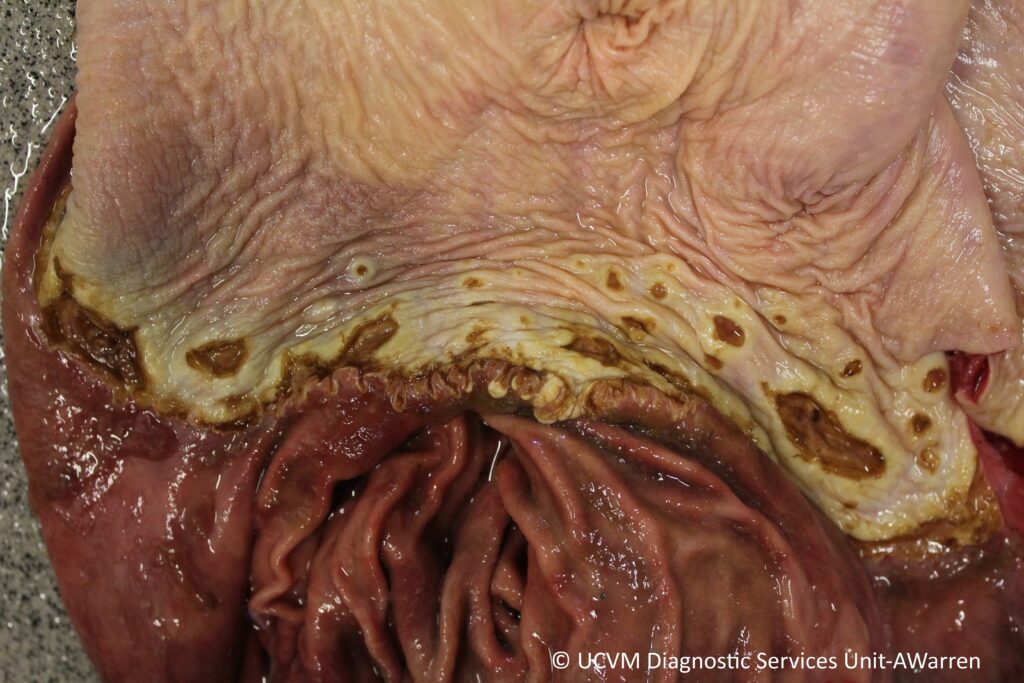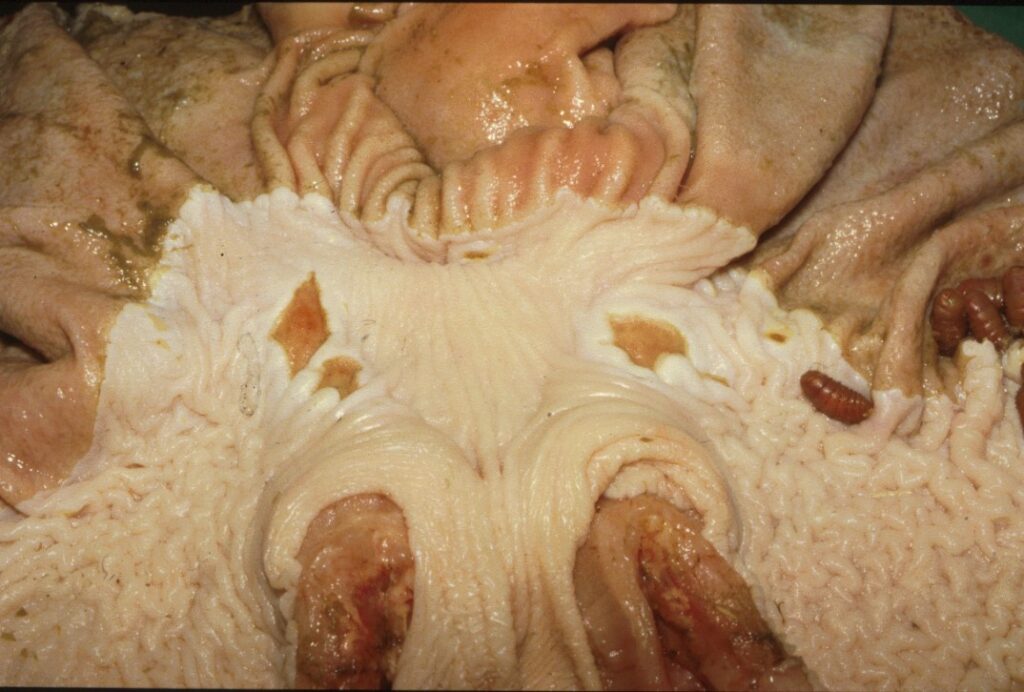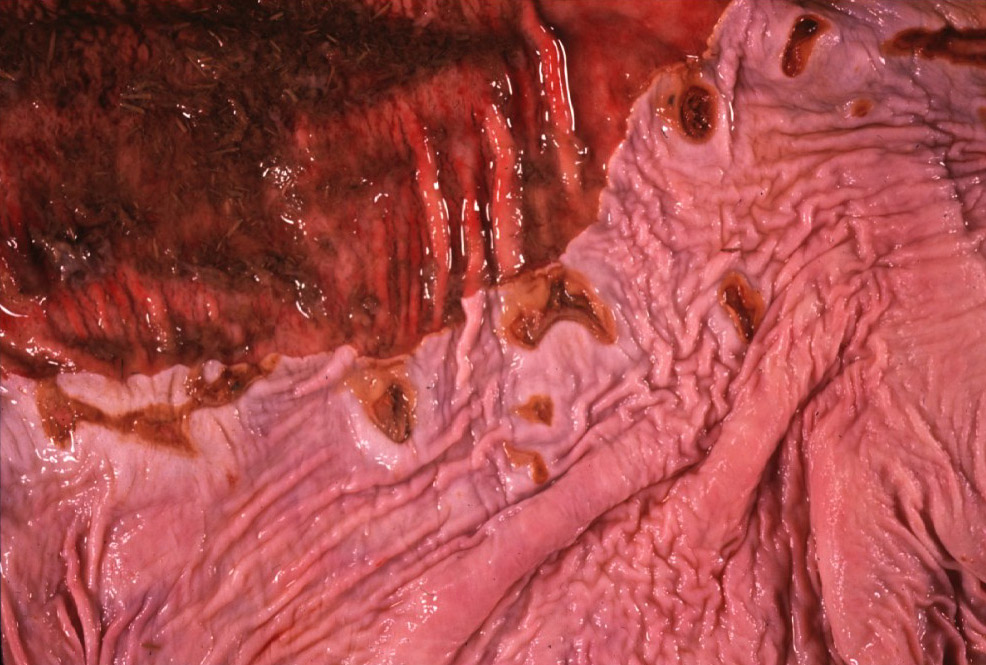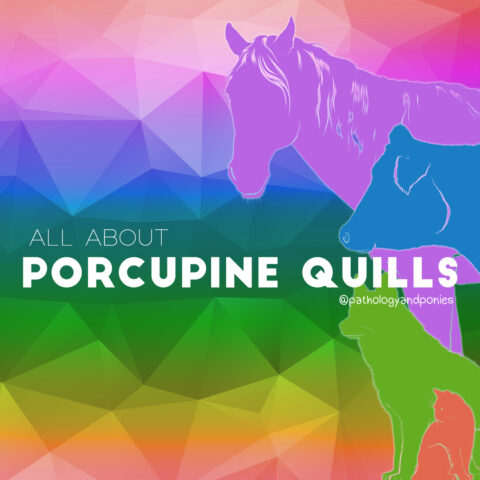Today’s path rounds are on 𝐠𝐚𝐬𝐭𝐫𝐢𝐜 𝐮𝐥𝐜𝐞𝐫𝐬! This was a request ![]()
𝐖𝐡𝐚𝐭 𝐢𝐬 𝐢𝐭?
Gastric ulcers are areas where the stomach 𝐦𝐮𝐜𝐨𝐬𝐚 (the lining) has become eroded, exposing the underlying tissue. This often associated with hemorrhage and inflammation.
𝐖𝐡𝐨 𝐠𝐞𝐭𝐬 𝐢𝐭?
All species can get this, but today we are going to talk about horses! They are probably the most frequently affected species with this disease, due to the unique anatomy of their stomach.
𝐖𝐡𝐚𝐭 𝐜𝐚𝐮𝐬𝐞𝐬 𝐠𝐚𝐬𝐭𝐫𝐢𝐜 𝐮𝐥𝐜𝐞𝐫𝐬?
As mentioned previously, the cause of gastric ulcers in horses is fairly unique. Horses have two types of mucosa in their stomach, a 𝐠𝐥𝐚𝐧𝐝𝐮𝐥𝐚𝐫 𝐭𝐲𝐩𝐞 that produces stomach acid and a protective mucous layer, and a 𝐧𝐨𝐧-𝐠𝐥𝐚𝐧𝐝𝐮𝐥𝐚𝐫 𝐭𝐲𝐩𝐞 that is pretty much the same as mouth mucosa with no protective mucous. Now imagine if you tried to drink a super acidic substance how crappy your mouth would feel! That’s basically what happens to the non-glandular mucosa in the horse’s stomach. Pretty much any time the stomach acid splashes up onto this mucosa it can get an acid burn, producing an ulcer.
𝐓𝐡𝐚𝐭 𝐬𝐞𝐞𝐦𝐬 𝐥𝐢𝐤𝐞 𝐚 𝐡𝐨𝐫𝐫𝐢𝐛𝐥𝐞 𝐝𝐞𝐬𝐢𝐠𝐧 𝐟𝐥𝐚𝐰.
Yup, you would be right! Especially with how horses live now. In their “natural state”, horses would be eating entirely forage based diets, nearly all hours of the day. However, we don’t tend to manage horses in this manner! Domesticated horses are often fed large amounts infrequently, leaving them with long periods without food. Horses constantly produce stomach acid, so having these long breaks with nothing to digest allows gastric acid to accumulate, and the stomach content to become very fluid, allowing splashing. Additionally, horses are often fed high-grain diets, which can increase the acidity of stomach acid and make it more damaging to the non-glandular mucosa. Both of these factors, combined with intensive exercise which can cause splashing of the stomach contents, set horses up to get gastric ulcers very easily. In fact, it is estimated that 60-90% of adult horses have gastric ulcers!
𝐖𝐡𝐲 𝐚𝐫𝐞 𝐭𝐡𝐞𝐲 𝐚 𝐩𝐫𝐨𝐛𝐥𝐞𝐦?
If you’ve ever had heartburn, you can probably relate to a horse with gastric ulcers. Horses have abdominal pain, don’t want to eat, don’t want to exercise or train, may lay down frequently or even show signs of colic. Additionally, with severe enough ulcers, there is a risk of 𝐠𝐚𝐬𝐭𝐫𝐢𝐜 𝐩𝐞𝐫𝐟𝐨𝐫𝐚𝐭𝐢𝐨𝐧, where the stomach acid may eat a hole all the way through the stomach wall, releasing stomach contents into the abdomen. Very not good!
𝐇𝐨𝐰 𝐢𝐬 𝐢𝐭 𝐝𝐢𝐚𝐠𝐧𝐨𝐬𝐞𝐝?
Gastric ulcers are diagnosed by 𝐞𝐧𝐝𝐨𝐬𝐜𝐨𝐩𝐲, which is where they stick a camera on a very long tube through the horse’s nose and into their stomach. From there, they can visualize the ulcers and come to a definitive diagnosis. At necropsy, we typically see thick, white to yellow nodules along the junction between the glandular and non-glandular stomach, a line called the 𝐦𝐚𝐫𝐠𝐨 𝐩𝐥𝐢𝐜𝐚𝐭𝐮𝐬. These nodules are areas of inflammation, where the body is responding to the damage and trying to heal. Sometimes we can also see “fresh” ulcers, which are usually bright red erosions in the normal mucosa.
𝐇𝐨𝐰 𝐢𝐬 𝐢𝐭 𝐭𝐫𝐞𝐚𝐭𝐞𝐝?
Gastric ulcers are typically treated with medication, with the goal of reducing the amount of stomach acid in the stomach. The typical treatment is 𝐨𝐦𝐞𝐩𝐫𝐚𝐳𝐨𝐥𝐞, which prevents the release of stomach acid from the cells that produce it. Lifestyle changes can help to, including more frequent meals, reducing grain, and decreasing stress.
𝐏𝐡𝐨𝐭𝐨𝐬
1) Diagram of the normal equine stomach. Note the difference in colour between the non-glandular, nice and pink mucosa and the darker glandular mucosa.
2-4) Equine gastric ulcers at necropsy. QOTD: Can you spot a little friend hanging out in one of the photos? Do you know what it is?
𝐒𝐨𝐮𝐫𝐜𝐞𝐬
Maxie, G. Jubb, Kennedy and Palmer’s Pathology of Domestic Animals, Volume 2. Sixth Edition.
Sykes, B.W., Hewetson, M., Hepburn, R.J., Luthersson, N., Tamzali, Y. European College of Equine Internal Medicine Consensus Statement — Equine Gastric Ulcer Syndrome in Adult Horse. Journal of Veterinary Internal Medicine 2015: 29(5), 1288-1299.
Photo 1 courtesy of Sykes et al.
Photo 2-3 courtesy of University of Calgary Diagnostic Services Unit.
Photos 4-5 courtesy of Noah’s Arkive.









